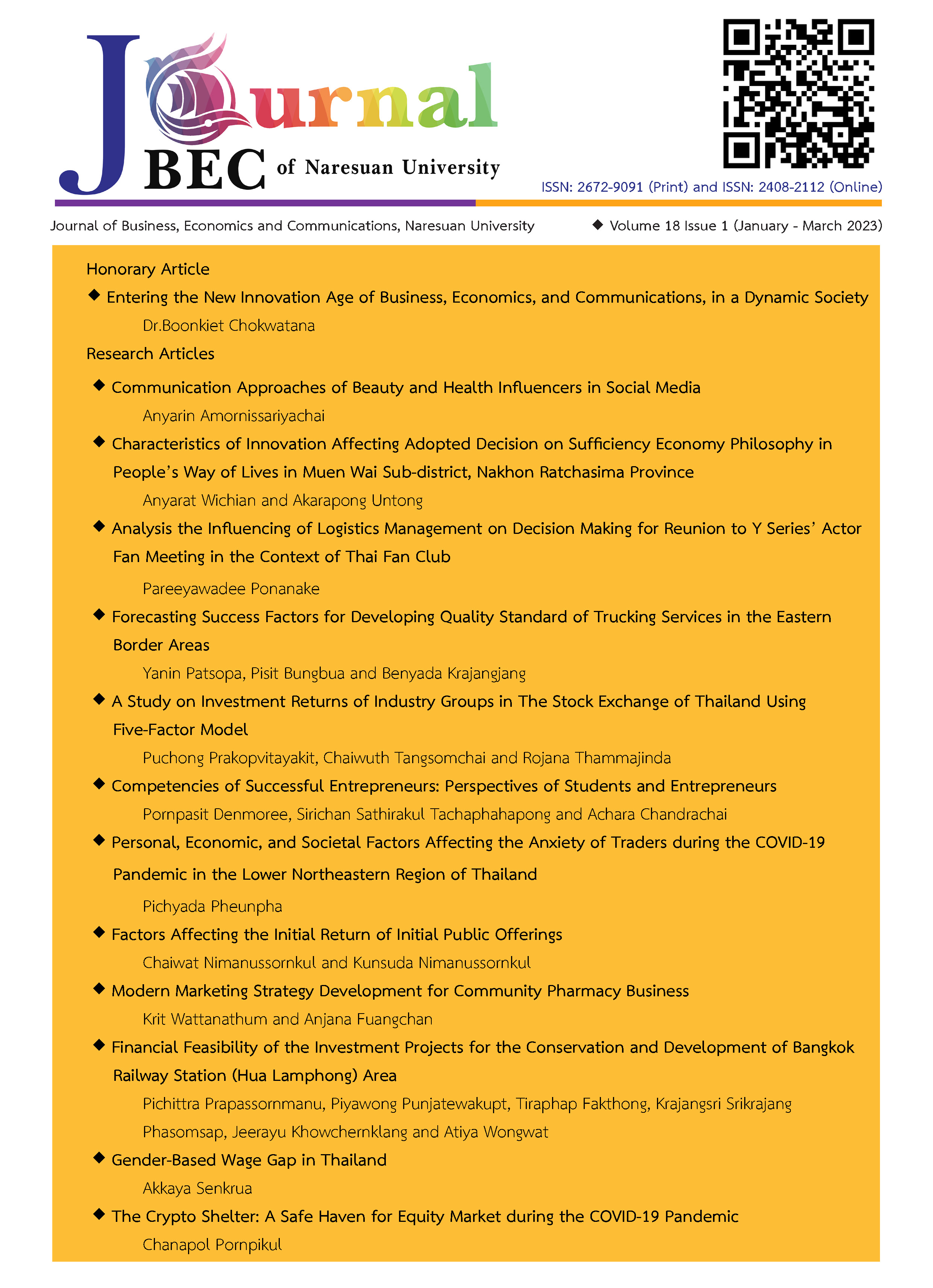Gender-Based Wage Gap in Thailand
Main Article Content
Abstract
Gender-based wage inequality is prevalent in countries around the globe, and Thailand is no stranger to gender wage discrimination. Specifically, this study is documentary research on pay differentials to investigate the factors contributing to the gender-based wage gap in Thailand by using wage decomposition methods. The findings indicate that the gender pay gap in the country has declined due to higher educational attainment of female workers. The male-female wage differential however remains despite the convergence in individual characteristics and endowments of male and female workers. The study also reveals that gender discrimination contributes to the persistent wage differential.
Article Details

This work is licensed under a Creative Commons Attribution-NonCommercial-NoDerivatives 4.0 International License.
References
Adireksombata, K., Fang, Z. and Sakellariou, C. (2010). The evolution of gender wage differentials and discrimination in Thailand: 1991-2007-An application of unconditional quantile regression. The Singapore Economic Review, 61(5), 1-31.
Becker, G. (1971). The Economics of Discrimination (2nd ed). Chicago: University of Chicago Press.
Blinder, A. S. (1973). Wage discrimination: Reduced form and structural estimates. The Journal of Human Resources, 8(4), 436–455.
Cotton, J. (1988). On the decomposition of wage differentials. The Review of Economics and Statistics, 70(2), 236-243.
Dasgupta, S., Bhula-or, R. and Fakthong, T. (2015). Earnings differentials between formal and informal employment in Thailand. ILO Asia- Pacific Working Paper Series. Geneva: International Labor Organization.
Heckman, J. (1979). Sample selection bias as a specification error. Econometrica, 47(1), 153-163.
International Labor Organization. (2013). Thailand - A labor market profile. Retrieved December 20, 2021, from http://www.ilo.org/asia/whatwedo/publications/ WCMS_205099/lang--en/index.htm
International Labor Organization. (2018). What lies behind gender pay gaps. Global Wage Report 2018/19. Geneva: International Labor Office.
International Labor Organization. (2019). ILO report on women in business and management: The Business case for change. Geneva: International Labor Office.
Jithitikulchai, T. (2016). Do Thai woman earn less than men in Thailand?. Retrieved April 12, 2021, from http://dx.doi.org/10.2139/ssrn.2984737
Juhn, C., Murphy, K. M., and Pierce, B. (1991). Accounting for the slowdown in black-white wage convergence. In Kosters, M. (Ed.), Workers and their wages. Washington DC: AEI Press.
Juhn, C., Murphy, K. M., and Pierce, B. (1993). Wage inequality and the rise in returns to skill. Journal of Political Economy, 101(3), 410-442.
Kaufman, B. and Hotchkiss, J. (2006). The Economics of Labor Markets (7th ed.). Ohio: Thomson Higher Education.
Khorpetch, C. and Kulkolkarn, K. (2011). Gender wage discrimination in the Thai labor market. Applied Economics Journal, 18(2), 17-31.
Lathapipat, D. (2009). Changes in the Thai wage structure before and after the 1997 economic crisis. Retrieved December 15, 2021, from http://dx.doi.org/10.2139/ ssrn.1483584
Leetrakul, P. (2011). Affecting factors of wage differentials between female and male in Thailand labor market. Economics and Public Policy, 5(9), 38–54.
Liao, L. and Paweenawat, S. W. (2019). Parenthood penalty and gender wage gap: Recent evidence from Thailand. Journal of Asian Economics, 78(2), 101435.
Mahatthanasomboon, P. (1983). Male-Female wage differentials in urban labor market: Bangkok metropolis. Master’s Thesis, Thammasat University, Bangkok.
Maithongdee, N. (2010). Gender discrimination and wage differentials: The case of private employees in professional occupations (Unpublished master’s thesis). National Institute of Development Administration, Bangkok.
Maithongdee, N. (2014). Discrimination against women. Journal of Economics and Management Strategy, 1(2), 91-103.
Mincer, J. (1974). Schooling and earnings. In Schooling, experience, and earnings. Columbia University Press (pp. 41-63). Massachusetts: National Bureau of Economic Research.
Mutsalklisana C. (2011). Gender inequality in Thailand: Analysis of mean earnings differences. Ph.d dissertation, University of California, Riverside.
Nakavachara, V. (2010). Superior female education: Explaining the gender earnings gap trend in Thailand. Journal of Asian Economics, 21(2), 198-218.
Neuman, S. and Oaxaca, R. (2005). Wage differentials in the 1990s in Israel: Endowments, discrimination, and selectivity. International Journal of Manpower, 26(3), 217-236.
Neumark, D. (1988). Employers' discriminatory behavior and the estimation of wage discrimination. Journal of Human Resources, 23(3), 279-295.
Ninchainan, J. and Osathanankul, R. (2013). Gender wage differentials in regional labor market. Journal of Economics, 17(1), 44-71.
Oaxaca, R. L. (1973). Male–female wage differentials in urban labor markets. International Economic Review, 14(3), 693–709.
Oaxaca, R. L. and Ransom, M. R. (1994). On discrimination and the decomposition of wage differentials. Journal of Econometrics, 61(1), 5-21.
Phananiramai, M. and Ingpomprasith, N. (1993). Analysis of changes in male-female wage differentials. TDRI Quarterly Review, 8(2), 25-32.
Poggi, A. (2014). Within-establishment wage inequality and satisfaction. Economics, 8(4), 1-21.
Poonsab, C. (2008). Analysis of male-female wage differentials in Thailand. Retrieved January 10, 2022, from http://research.mol.go.th/rsdat/data/doc/KDJKNu1/01KDJKNu1. pdf
Ramos, A. (2016). Gender wage discrimination in the Philippine labor market. UMBC Review, 17(1), 108-127.
Ransom, M. R. and Oaxaca, R. L. (1994). On discrimination and decomposition of wage differentials. Journal of Econometrics, 61(1), 5-21.
Rebecca, C., Yogi, V., Riyana, M. and Justine, M. (2009). The impact of a sustained gender wage gap on the Australian economy. Retrieved March 23, 2021, from https://mel bourneinstitute.unimelb.edu.au/assets/documents/hilda-bibliography/conference-pa pers-lectures/2010/Cassells_etal_gender_wage_gap.pdf
Reimers, C. W. (1983). Labor market discrimination against Hispanic and Black men. Review of Economics and Statistics, 65(4), 570-9.
Schober, T. and Winter-Ember, R. (2009). Gender wage inequality and economic growth: Is there really a puzzle. Retrieved March 23, 2021, from https://www.econstor.eu/bit stream/10419/73647/1/665646941.pdf
Son, H. H. (2007). Occupational segregation and gender discrimination in labor markets: Thailand and Vietnam. Retrieved March 23, 2021, from http://hdl.handle. net/11540/1868
Srisomboon, R. (2016). Market interruption and gender earning gap in Thai labor market. University of the Thai Chamber of Commerce International Journal of Business and Economics, 8(1-7), 101–132.
Taniguchi, K. and Tuwo, A. (2014). New evidence on gender wage gap in Indonesia. ADB Economics Working Paper Series 404, Manila: Asian Development Bank.
Thi Bui, M. and Permpoonwiwat, C. (2015). Gender wage inequality in Thailand: A sectoral perspective. International Journal of Behavioral Science, 10(2), 19-36.
UNFPA. (2015). Features of Thai families in the era of low Fertility and longevity. Retrieved April 23, 2021, from https://thailand.unfpa.org/sites/default/files/pub-pdf/State%20of%20Thailand%20Population%20report%202015-Thai%20Family_en.pdf
Wathanumsuk, J., Sajjanand, S. and Srisawaluk, O. (2012). Gender pay gap: A case study of automobile industry at Well Grow industrial estates in Chachoengsao province. In The second STOU Graduate Research Conference. Nonthaburi: Sukhothai Thammathirat Open University.


